Help us improve your experience. See content that is made for you!
See how IBM increased their efficiency by up to 30%!

Help us improve your experience. See content that is made for you!
See how IBM increased their efficiency by up to 30%!

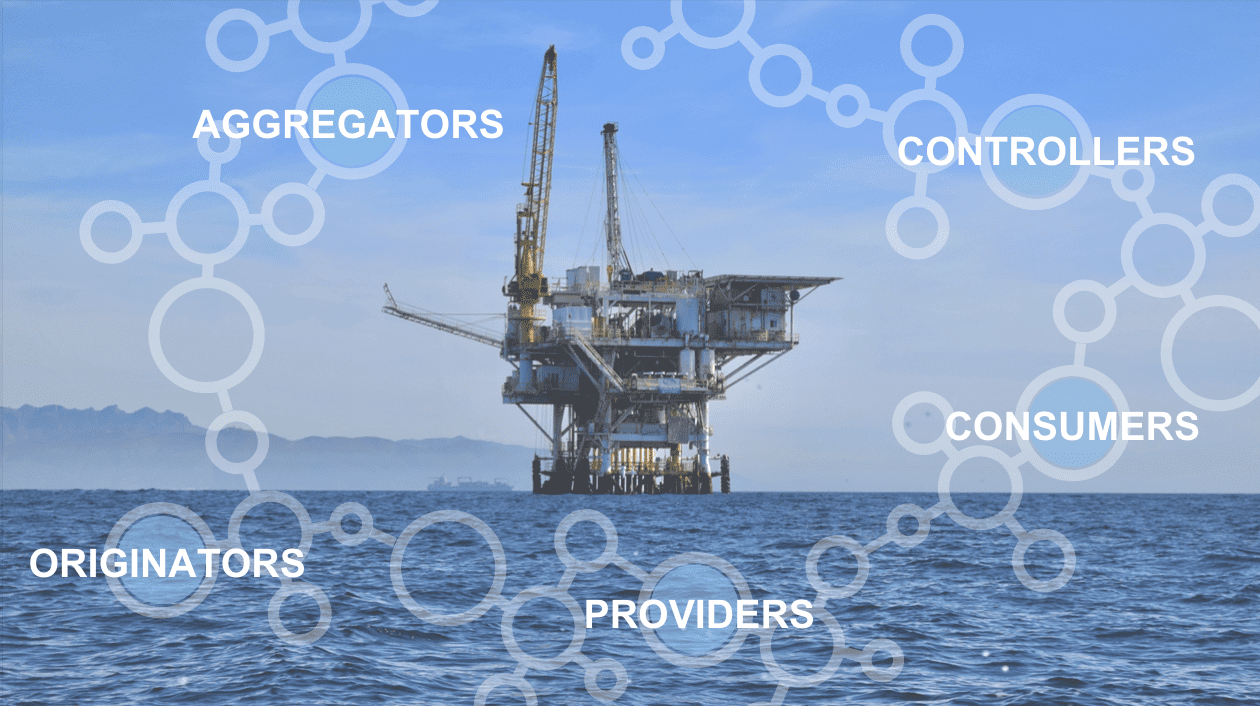
This article was co-written by Olivier Lepinoy, Senior Global Business Development Executive - Platform Subject Matter Expert, Autodesk & Giso van der Heide, Senior Customer Outcome Executive EMEA, AEC Strategic Accounts, Autodesk.
The construction industry is going through an invisible revolution. When we look at today's pioneering AEC firms, we see that they're all trying to reinvent themselves. They're collecting data, building digital platforms, operating new business models, and are offering new services in their ecosystem.
All of these have major implications on our field, but from the outside, the construction industry looks unchanged.
This is because the biggest changes happening right now are shifting how the industry is structured, and not the way things are built.
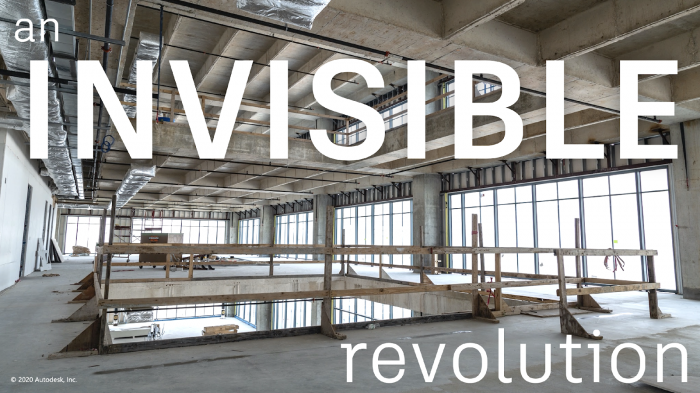
So if you visit a construction site, the physical environment looks very much the same, but the underlying mechanism supporting that site has shifted in a major way. The technologies used, the types of companies involved, and the business models and contracts between parties have evolved. Winning in today’s environment requires AEC companies to keep up with these changes.
To do that, you need to transform how you think and work in construction, particularly when it comes to your:
At Autodesk, we have a program called the Arc of Transformation, which helps firms be more intentional about their digital transformation. We want our clients to explore all the possibilities (performance, innovation, transformation) in order to make better decisions about their future. The program guides AEC companies throughout the changes they need to make to ensure the resiliency their business. We help them formulate and develop their strategic initiatives, and we create the conditions for their strategy to better executed.
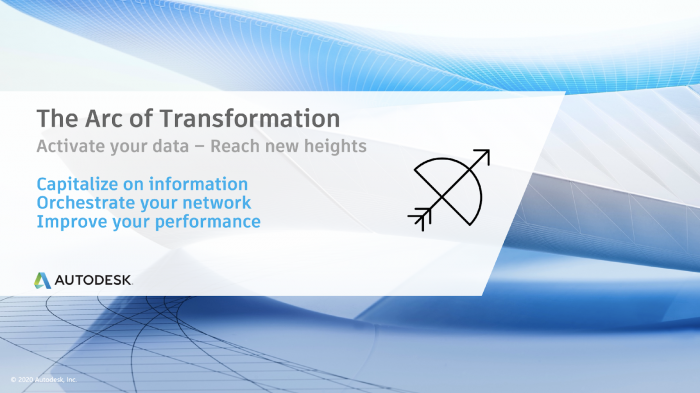
Let’s now take a closer look at the 3 components mentioned above and their role in AEC digital transformation.
The best in class AEC firms are launching strategic digital initiatives to improve their market position and build their competitive advantage. We can see numerous examples of these initiatives in action.
Take a look at the following:
We could go on, but by now you get the picture. Almost all construction companies are increasingly transforming how they operate by launching digital platforms.
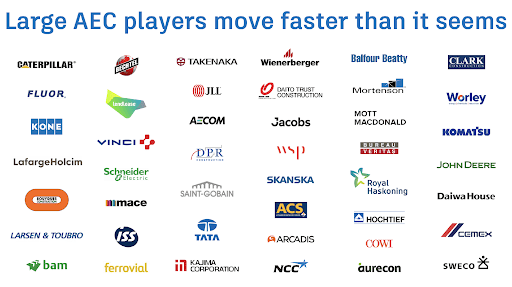
It’s also important to note that these initiatives aren’t just happening within the construction industry. Other digital-centric companies are entering the space as well.
There’s Amazon, which invested in a startup called Plant Prefab; this might be the first move towards industrialized construction. Meanwhile, Alphabet Inc., — Google’s parent company — has Sidewalk Labs, an "urban innovation company" that works to make cities more affordable and sustainable. Sidewalk Labs recently launched Delve, a new generative design tool for urban projects.
All this to say that the digitization of construction has reached new heights, and we can expect a lot more innovation going forward.
The significance of digital platforms doesn’t just lie on the platform or tech itself. It’s about how companies evolve as they adopt these technologies.
When players adopt new tech, they pick up new behaviors and they gain more experience and maturity.
Companies may start to use digital technologies to see outcomes like higher productivity, cost savings, and business optimization. But over time, businesses learn from the platforms. They become more experienced and data-centric, which leads to firms developing their own platforms — much like the examples we mentioned above.
These trends have become so prevalent that we believe we’ve entered a new era in construction. We’re no longer in the age of digitization, we are going through total business transformation.
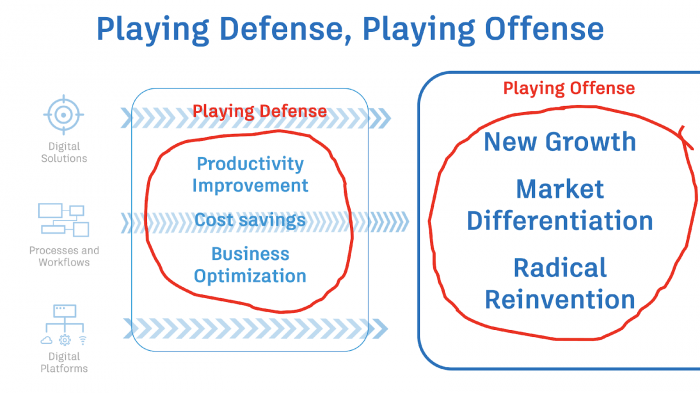
When you play offense, the rules of the game are different. Your strategies and your plans for playing defense are not appropriate for our offensive moves. You'll need to intensify your digital efforts. Instead of simply testing or developing solutions, you also need to scale those solutions across your company, and even within the ecosystem of companies around you. You cannot just tweak your processes and workflows. You need to define new ones.
In construction, today’s value chain is sequential and fragmented. Companies are paralyzed by the same status quo: low productivity, low predictability, low margins, adversarial pricing models, financial fragility, lack of collaboration, lack of investment in R&D and Innovation, poor image and attractivity. Meanwhile, society is increasingly concerned that the sector is not able to meet the imminent challenges. It has become obvious that technology alone will not provide the needed solutions. A new mindset is imperative. It is now clear to everyone that implementing a successful digital transformation means changing or diversifying your business model.
We've identified three strategic moves to enable this, and they are: acquisition, new ventures, and alliances. Each one reflects a growth strategy and a type of business model diversification.
Let's look at each of these strategies more closely.
This is a common growth strategy in AEC, and it involves a larger company acquiring a smaller one and bringing the latter's business model and technologies into the fold.
In construction, an example of a firm that uses acquisition as a driver of growth is VINCI. The group now owns and manages a wide portfolio of companies and business models. This has enabled the group to diversify its activities; so much so that calling VINCI a "builder" would be incorrect. The company is so much more than that. It is a global investor, designer, builder and operator of buildings and infrastructure. The entities in VINCI Concessions business design, finance, build and operate transport infrastructure and public amenities under public-private partnership agreements. The Contracting business of VINCI brings together a vast array of expertise in energy and information technology, road and rail works, building and civil engineering.
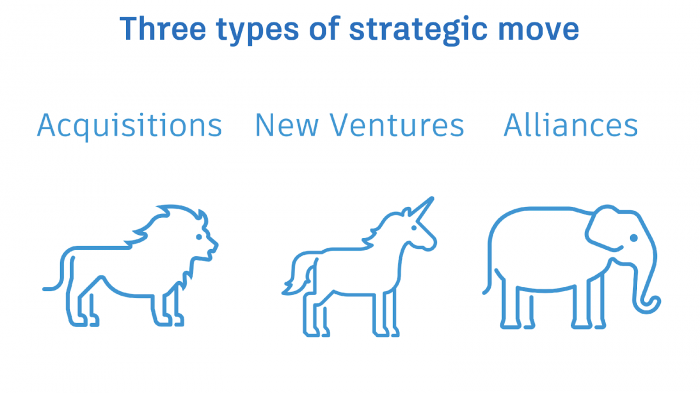
New ventures are all about launching new businesses and starting from scratch. We see firms approaching this strategy in three different ways.
The first is to enter new markets. We see this in large AEC firms that get into new business ventures to test ideas developed in their corporate innovation labs. When they do this, they try to conquer new markets. They want to penetrate markets outside of their home ground.
One example is when Ferrovial launched KUIKO, a platform that enables professionals to find, select and hire the best local professionals for repair, maintenance and cleaning. This is now the first digital solution in Spain for facility management services.
Type two is industrialization. In AEC, this is often a path taken by contractors that want to find new ways to build. We see these new ventures in large construction companies like DPR, Mace, Balfour Beatty, and more. These companies are still doing the same thing (e.g., building an asset) but they want to do it differently. Industrialized construction is now a major trend and the industry is at a tipping point, as explained by Amy Marks in this presentation at Autodesk University 2020.
The third type of new venture is all about leaving AEC. Type three happens when a firm launches a venture that's completely outside architecture, engineering, and construction.
Ferrovial, for instance, has a mobility division. When they developed Wondo and ZITY, the target markets were outside of AEC. Wondo is a start-up providing urban mobility services that assigned cooperation agreements with taxi, car-sharing services and private bus companies. ZITY is an electric car sharing company. It is a joint venture between Renault and Ferrovial and its business model is based on renting electric vehicles by the minute.
Alliances are when different companies come together and collaborate on a project or venture.
A famous example is BoKlok, a venture developed by Skanska and IKEA. This started in the '90s, and they came together to offer sustainable, quality and low-cost homes to people. It’s a successful business which uses industrialized construction to build homes. With BoKlok, Skanska and IKEA now influence every part of the ecosystem. Somehow, they managed to bridge the gab between being a designer, a builder and a supplier. It is the full integration of several lines of work.
Another example of alliance is the business created by Royal BAM with Saint-Gobain on 3D printing. The two companies have joined forces to set up Europe’s first 3D printing factory for concrete elements.
Regardless of the growth engine (whether it’s acquisition, new venture, or alliance), one thing remains clear: boundaries between the silos and categories we know are increasingly blurring. Hybrid players are gaining importance and the diversification of business models is starting to become the new normal.
The industry is made of networks of companies with various levels of maturity and different strategies and goals. You have pioneers, trailblazers, leaders, front runners, and you have others who follow. With increased digital initiatives, data centricity, and platforms, a new network of companies will grow and expand. It will grow even bigger and boundaries between the categories we know will progressively disappear.
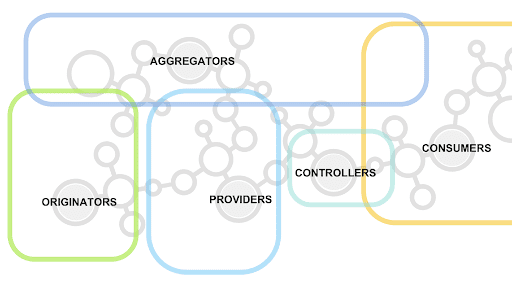
At an industry level, we expect to see the emergence of new types of players and ecosystems:
The third component of digital transformation lies in the company culture. The way things are done, as well as the behaviors, beliefs, and perceptions within your company need to be disrupted to give way to the digital revolution.
Cultural change within an organization can take many forms and levels. One is by reinventing the roles, activities, and terms we use to describe things. It is easy to see that terms we currently use to describe the roles of the players are outdated. One aspect is the emergence of new roles and departments in firms centered around data and analytics, especially at the C-suite. Positions like Chief Data Officer, Chief Transformation Officer, and Chief Partnership Officer are starting to emerge.
These changes aren’t just about semantics. Today's environment calls for new activities and roles, and having the right terminology helps shift the way that people think and work. Establishing new roles and terminologies also changes how an organization sees itself, and ultimately shifts its behaviors and actions over the long term. We believe this is one of the missing pieces of the puzzle. A lot of initiatives fail because this domain is underestimated.
To build resiliency and future proof businesses, what is essential is a sharp and well-balanced execution: “doing the right thing, at the right time”: build the right digital platform, expand your portfolio of business models, build the right ecosystem, nurture the right culture and behaviors.
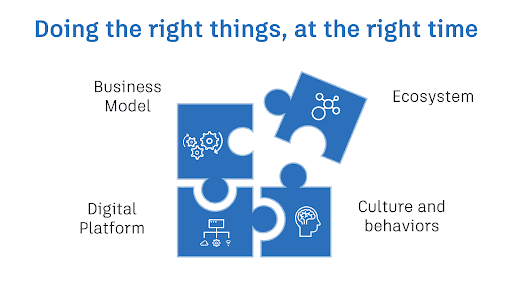
A key ingredient when taking action in today’s digital environment is agility. Being quick and agile with your initiatives is a must for keeping up in our rapidly-changing industry. As such, agility needs to baked into your organizational culture
As Jeff Bezos put it:
“The only sustainable advantage you can have over others is agility, that's it. Because nothing else is sustainable, everything else you create, somebody else can replicate.”
Whether you play defense or offense, you need to be able to measure the results of your activities and make sure you unlock the potential of Autodesk technology. The best way to do this is to think in terms of outcome: a tangible and measurable business result that you want to achieve, in order to improve the performance of your business.
Autodesk works with a wide variety of companies across many industries and markets. While every company is unique, we see many common goals. Decades of experience have helped us understand which technology & capabilities can have the biggest impact. In this new era of convergence, the Autodesk Industry Outcome Framework helps you measure your current capabilities, define better workflows and capture more value. This scalable method guides you on how to set the right priorities, establish a solid program and quickly achieve clear business outcomes. To put it another way, we help you find a recipe — a repeatable sequence — for success.
Transforming an AEC firm is never easy. We know it is a journey and we offer to be the catalyst of your transformation, from strategy to execution.
You can use the Arc of Transformation program to set a strong vision and formulate your strategic intent. Here, we help you understand the global competitive context, and find the right focus among all the possibilities (performance, innovation, transformation). Ultimately, we help you build your strategic initiatives.
The AEC Business Model Playbook is incorporating all relevant elements that are necessary to guide you from strategy to implementation. Like “pealing an onion”, it starts with the business model at the center and thereafter we plug in the Autodesk Industry Outcome Framework.
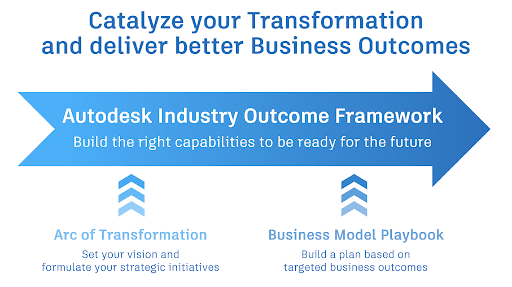
We do not want to re-design your strategy. We want to create the conditions for your strategy to be well executed. Our approach is always tailor made. Each company can create its own recipe with the ingredients we offer. Each business outcome is specific to each company and there are multiple ways to achieve a defined business outcome.
All in all, these programs help you bridge the gap between business and innovation, accelerate the scaling of your digital capabilities and sustain your digital capabilities in the long term. We encourage you to explore them, so you can discover how to be a stronger player in today’s invisible revolution.
For more on this topic, watch this presentation from Autodesk University 2020: New Business Models and Digital Platforms in Construction 4.0
Here are some additional resources that may help you.
The foresight report published by the European Network of Construction Companies for Research and Development (ENCORD). It is a plea for business model innovation.
The Autodesk – RICS report on industrialized construction and the future of work. It can be found here. It explains where the industry is going and what new roles and skillsets are needed now and in the near future.

May we collect and use your data?
Learn more about the Third Party Services we use and our Privacy Statement.May we collect and use your data to tailor your experience?
Explore the benefits of a customized experience by managing your privacy settings for this site or visit our Privacy Statement to learn more about your options.